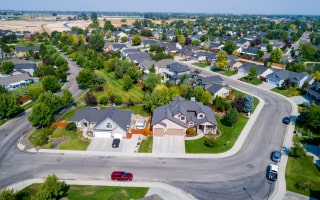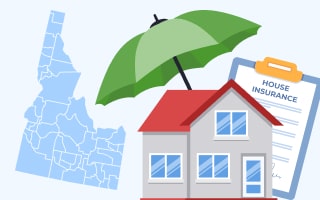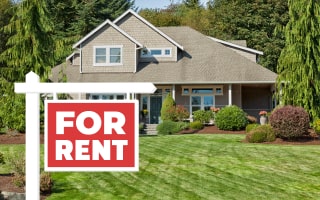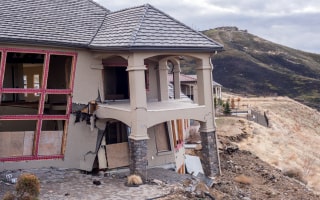Homeowners Insurance in Idaho

The great state of Idaho is known for spuds (potatoes), but did you also know that Idaho is subject to severe earthquakes, wildfires, and winter storms? All of which can destroy or damage a property. Extreme heat, thunderstorms, and floods are also part of what makes up Idaho's weather pattern. Since 1953, Idaho has had 44 federally declared natural disasters, and the rate of disasters per 1 million people in Idaho is 22.11.
Along with the dangers to homes listed above, Idaho residents also must deal with break-ins, vandalism, frozen pipes in the winter, ice dams and heavy snow, trees falling on the house, and windows shattering during earthquakes or tumultuous summer storms.
No U.S. state requires homeowners insurance, but experts highly recommend that every homeowner have some. However, if you borrow money to buy property in Idaho, your lender will require that you keep specific limits of coverage on your home until the loan is paid off.
The average homeowners insurance cost in Idaho is $1,282 for $300,000 of dwelling coverage. The national average for the same amount of coverage is $2,270, making Idaho rates 56% lower than the rest of the county.
Types of Homeowner Insurance Coverage Available in Idaho
Every part of the country has its distinctive weather patterns and inherent perils. Depending on your location and the providers available, you can purchase specific types of homeowners insurance to cover your property in Idaho. The types available in Idaho are:
-
Dwelling Coverage: Dwelling coverage pays to replace or repair the structure of your home if it is destroyed or damaged by a covered peril. For example, if your house burns down, the dwelling coverage will rebuild it to its previous standard.
-
Liability Coverage: If someone gets hurt on your property (e.g., falling on icy steps) and they sue you, liability coverage will pay your legal bills.
-
Guest Medical Coverage: If someone is injured on your property, guest medical will pay their medical bills.
-
Personal Property Coverage: Personal property coverage pays to replace your personal belongings, such as furniture, clothing, electronics, etc.
-
Other Structure Coverage: Other structures coverage refers to detached buildings and items like pools, fences, sheds, garages, and hot tubs.
-
Additional Living Expenses (ALE) Coverage: If you are forced to leave the home while it is repaired or rebuilt, ALE coverage will pay for your living expenses (hotel, food, laundry, etc.).
Home Insurance and Natural Disasters
The home insurance market is in turmoil due to increasing natural disasters like wildfires, storms, and floods. Climate change is the most significant factor driving insurance rate increases. Experts estimate roughly 25% of American homes are undervalued and underinsured and won't be able to be restored in the event of disaster. Over the last five years, insurance rates have increased by 34% and, in some places, more than 60%. From 2018 to 2023, Idaho saw an increase of 29.6%.
One of every four property damage claims is for fire or lightning damage, the costliest type of claim. In 2020, 6% of homes filed a claim for homeowners insurance. Each claim for fire or damage due to lightning costs insurers $77,340. Wind and hail are also issues for Idaho residents, costing insurance providers $11,695 per claim. Water damage and floods cost insurance providers $11,650 for each incident. Other random damage issues cost about $6,773 per claim. Idaho has seen 31 billion-dollar disasters from 1980 to 2024. Idaho had five tornados in 2023 alone. By far, the most damaging peril in Idaho is wildfires. The state saw 1,088 wildfires in 2022, damaging 436,733 acres of land.
Idaho also sees some floods, and insurance providers urge residents to insure themselves with flood coverage.
FEMA (Federal Emergency Management Agency) manages the National Flood Insurance Program (NFIP) through a network of 50 providers across the U.S.
Since most homeowners insurance does not cover floods, this supplemental coverage can repair damage and replace items after a flood. Depending on the options you choose, it can cover the building and/or your personal belongings. This program is available to homeowners, renters, and businesses. Learn more about the program on FEMA's website.
How Can I Save on Homeowner Insurance Premiums in Idaho?
Home insurance can be expensive, and many factors impact rates. Some of the most prominent things that affect how much you pay for home insurance are:
-
Location: Where you live affects your rates more than any other factor. If you live in an area prone to disastrous weather, you will pay more than if you live in a quiet, safe location with very few perils.
-
Age, Size, and Condition: The age, size, and condition of your home also matter. The larger the house, the more it will cost to rebuild it. Older homes, as well as poorly maintained homes, are more expensive to insure.
-
Your Deductible: The higher your deductible, the lower your premiums.
-
Claims History: Your rates will be lower if you have a clean claims history. The more claims you have, the higher the risk, and your rates will increase.
-
Level of Coverage: The more coverage you have, the higher your rates.
-
Cost of Materials & Labor: As the costs of materials and labor increase, so will your insurance rates.
-
Your Credit Score: If you have good credit, you will pay less than someone with poor credit.
-
Risk Factor: If you have "attractive nuisances" like pools, hot tubs, or a trampoline, your risk factor will be higher, and so will your rates.
Because Idaho experiences some extreme weather and property damage, it's essential to try to save on your home insurance. Some ways to do this are:
- Shop Around: Talk to family, friends, and colleagues to find out who the best insurance carrier in your area is. Get quotes from multiple companies and compare them before deciding.
- Increase Your Deductible: Raise your deductible, and your rates will decrease.
- Reinforce Your Home: Make your home more storm-resilient with storm shutters, fire-resistant materials, and a sprinkler system to prevent damage and claims and qualify for insurance discounts.
- Bundle: Buy multiple policies from the same carrier, and they will cut your rates as a courtesy discount.
- Install Security: If you live in a high-crime area, install a security system, smoke alarms, and other safety features to protect yourself and your home. Your insurer will discount your rates.
Home Insurance Discounts in Idaho
Home insurance protects your property, which will pay to replace or repair your home and other things in the event of a disaster. A typical home insurance policy will include dwelling, personal property, liability, medical payments, other structures, and ALE coverage. Depending on your coverage and insurance provider, your rates may vary.
You can obtain home insurance in a few ways. Contact a local insurance agent and ask for their help. You can go online and apply through the company website or use a phone number to apply. Always shop around to get the best quotes. Once you decide on coverage and select your provider, you must pay for the first year in advance. After that, you can pay annually or through your mortgage escrow.
Because home insurance can be pricey, trying to qualify for as many discounts as possible is a good idea. Some of the more common discounts providers offer include:
- Lower Risk: Anything that lowers your risk, like installing a security system or getting rid of a pool or trampoline, can afford you a discount.
- Senior Discount: Seniors may be eligible for discounts on home insurance.
- Occupational Discount: Some occupations, like teachers and firefighters, earn discounts on home insurance.
- Vet/Military Discount: Most providers offer a discount for people in the military or retired vets.
- Bundle: Bundle your policies to get an overall discount on all your coverages.
- Claims Free: Stay claims-free for as long as possible and earn higher discounts every year.
- Loyalty/Payment Method: Stay with the same company for many years, and they may decrease your rates over time. Signing up for auto payments may earn you a slight discount as well.
Common Rates Offer by Homeowners Insurance Firms
The average rate for home insurance on a new home in Idaho is $1,510/year or $126/month. New homes cost less to insure because they are constructed according to code with better materials and would be less expensive to rebuild in the event of a disaster. New home insurance can cost up to 40% less than an older home. However, your actual rate will vary based on your age, credit score, claims history, and other factors. Rates also vary by provider.
Top 10 Home Insurance Firms in Idaho and Average New Home Savings
| Company | % savings |
|---|---|
| Nationwide | 76% |
| USAA | 54% |
| Allstate | 47% |
| Travelers | 63% |
| American Family | 55% |
| Idaho Farm Bureau | 42% |
| Oregon Mutual | N/A |
| Mutual of Enumclaw | N/A |
| Chubb | N/A |
| Country Financial | N/A |
Home Insurance and Renovations in Idaho

Home renovations can dramatically enhance your home's beauty and value but could also raise your insurance premiums. Some renovations lower your risk and rates, but others increase them. Others may have no effect as they may both increase and decrease rates and cancel themselves out.
![]() Home Renovations that Increase Rates
Home Renovations that Increase Rates
Some home renovations that increase insurance rates are:
- Adding Square Footage: Adding more space means more value, and rebuilding the house after a disaster will be more expensive. Your rates will increase.
- High-End Upgrades: Expensive upgrades such as appliances, flooring, and fixtures will be more expensive to replace, thus higher rates.
- Adding Attractive Nuisances: Adding a fireplace, pool, hot tub, or trampoline can add to the fun but will also increase your rates because these attractive nuisances add more risk.
![]() Home Renovations that Decrease Rates
Home Renovations that Decrease Rates
Some home renovations that decrease insurance rates are:
- Home Security System: If you live in a high-crime area, installing a home security system could earn you better home insurance rates.
- Weather-Proof Roof & Windows: Replacing your windows and roof with stronger, more resilient materials that weather storms better could lower your home insurance rates.
- Replacing Plumbing or Electrical Systems: Old wiring can lead to fires, and bad plumbing could cause water damage. Replacing these systems could save you money on your home insurance.
Some things that may have no effect are replacing your siding (unless you use really expensive materials) and solar panels. Although they add value, they also lower risk.
Although home insurance will protect you from theft, injury, or disasters during a renovation, it does not pay for the renovation itself. Anything you choose to upgrade, you will have to pay yourself. Insurance only covers damage caused by a covered peril.
Before starting work, discuss any upcoming upgrades or renovations with your insurance agent. Find out how these will impact your rates and coverage. You might need to increase your coverage after the work is completed.
Idaho Renters' Insurance

People who rent apartments, condos, and houses also need homeowners protection. However, these policies work differently. First, they do not include any dwelling coverage. The owner's policy must cover that. So, as a renter, your policy will not pay to rebuild your home if it burns down. Renters insurance does include personal property coverage, liability coverage, medical payments, and ALE insurance if you are displaced due to a disaster.
Renters insurance pays for your belongings (clothing, furniture, sports equipment, electronics, etc.), but it won't pay for fixtures like appliances. Some of the covered events with renters insurance are:
-
Fire
-
Smoke
-
Explosions
-
Vandalism
-
Theft
-
Lightning
-
Windstorms
-
Water Damage Due to Broken Pipes
Renters insurance typically does not cover earthquake or flood damage.
A few things factor into the price of renters insurance, such as:
-
Location: If you live in urban areas with more crime, your rates will be higher.
-
Coverage Limits: The more coverage you have, the higher your rates.
-
Number of Units: The more units in your building, the lower your rates.
Idaho renters insurance is extremely affordable, with an average rate of $11/month or $131/year. The state has some of the lowest rates in the U.S.
Condo Insurance in Idaho

Condo owners also need homeowners insurance. Insurance providers offer HO-6 insurance for condo owners, which works slightly differently than homeowners insurance. Each condo association has a master insurance policy that covers the dwelling. If an event like a fire destroys the building, the master policy will rebuild it and restore it back to its original condition. Over time, condo owners upgrade things like appliances, fixtures, flooring, etc. Their HO-6 condo insurance policy will kick in and replace those upgrades to bring the condo back to its current condition after the event. Condo insurance is sometimes called "walls-in", meaning it only covers the condo's interior.
Condo insurance differs from renters insurance in that it includes some dwelling coverage but only walls-in coverage. Plus, if anyone gets hurt, the liability insurance only covers them if they get hurt inside the condo, not outside on common grounds.
A typical condo insurance policy will cover walls-in-dwelling coverage, personal property, liability, medical payments, loss of use, and loss assessment. Some covered events are fire, storms, theft, vandalism, etc. In the event of a claim, your policy will replace:
- Furniture
- Clothing
- Appliances
- Interior Walls
- Wiring/Plumbing
- Flooring
- Light Fixtures
- Countertops
- Cabinets
- All Your Personal Possessions (with some limitations)
The average rate for condo insurance in Idaho is $486/year or $41/month with a $1,000 deductible, $60,000 in personal property coverage, and $300,000 in liability protection.
Some ways to save on condo insurance are to bundle policies, increase your deductible, skip small claims, opt-in for automatic payments and paperless statements, install a security system, reduce risk, and ask about other discounts.
Idaho Home Insurance Market
Unlike most states that have seen significant losses over the past few years, Idaho insurers have broken even for the last three years. In 2018, the homeowners insurance market in Idaho experienced a considerable loss due to multiple wildfires. If current trends continue, residents should not experience high rate increases or providers leaving the state.
A few of Idaho's big issues are earthquakes, wildfires, and winter storms. These things dictate the health of the home insurance industry. The more claims, the higher the rates, and if losses continue, some insurance providers refuse to offer insurance in that state.
No federal agency regulates insurance providers. Each state has a designated department that regulates, monitors, and sanctions insurers. They also field customer complaints and perform investigations. In Idaho, this agency is the Idaho Department of Insurance, located at 700 West State Street, P.O. Box 83720, Boise, ID 83720-0043.
Homeowners Insurance Guide
- Homeowners Insurance in Idaho
- Types of Homeowner Insurance Coverage Available in Idaho
- Home Insurance and Natural Disasters
- How Can I Save on Homeowner Insurance Premiums in Idaho?
- Home Insurance Discounts in Idaho
- Home Insurance and Renovations in Idaho
- Idaho Renters' Insurance
- Condo Insurance in Idaho
- Idaho Home Insurance Market
Instant Access to Idaho Property Records
- Owner(s)
- Deed Records
- Loans & Liens
- Values
- Taxes
- Building Permits
- Purchase History
- Property Details
- And More!
Homeowners Insurance Guide
- Homeowners Insurance in Idaho
- Types of Homeowner Insurance Coverage Available in Idaho
- Home Insurance and Natural Disasters
- How Can I Save on Homeowner Insurance Premiums in Idaho?
- Home Insurance Discounts in Idaho
- Home Insurance and Renovations in Idaho
- Idaho Renters' Insurance
- Condo Insurance in Idaho
- Idaho Home Insurance Market